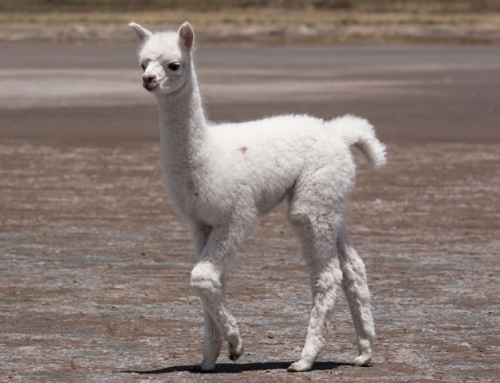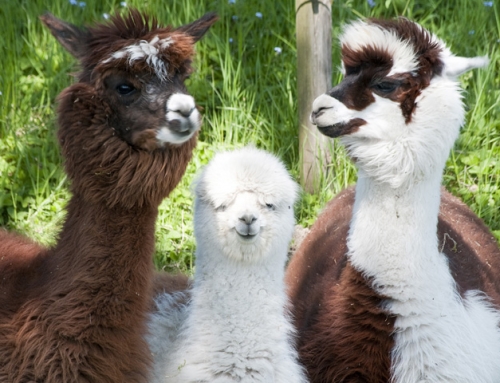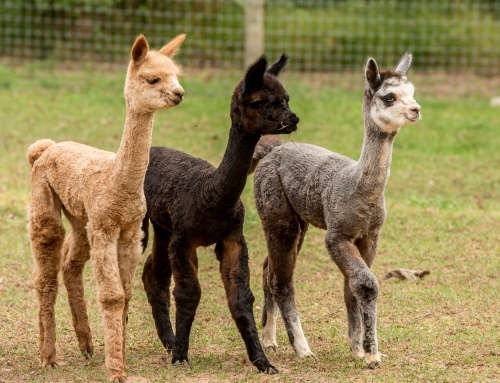When we first starting thinking about starting an alpaca farm, the first thing we did was find a mentor. They taught us everything that we need to know and still answer questions to this day. That, my friends, is your first tip. Find a great mentor and learn as much as you can from them!
Alpacas are some of the most unique and most amazing farm animals in you can find. They prefer colder climates but easily adapt to the warmer summer climates across North America. As long as you acknowledge extreme temperatures and adjust for them, with sprinklers or jackets, they will do just fine.
These great animals belong to the camelid family and originate from the Andes Mountains. Now they are breed in farms all over the globe for their luxurious wool. They are frequently mistaken for baby llamas but their are numerous differences between llama’s and alpacas, including size and ear shape.
If you are looking into staring an alpaca farm, we suggest that you do all of your homework ahead of time. While it is possible to make money in this business, it takes a plan and clear goals in order to due so. You can’t simply go out and purchase a few alpacas with the goal of getting rich. I guess that you can, but the results aren’t likely to be what you are looking for!
Here is a look at some of the tips on starting an alpaca farm:
How Much Land?
First thing’s first! When starting an alpaca farm, before you even buy the alpaca, you will need to set up a section of land that will accommodate them. To accommodate their natural living requirements, you will want to have a decent amount of land. Depending on the farmer and the pack, an acre of land can accommodate from 10-15 alpacas comfortably if you are feeding hay and not expecting them to live off pasture. If you are looking to have them live off of pasture’s, that number significantly decreases.
It is imperative that you separate male and females of breeding age. That means you should expect to have at least two separate pens, but a study by The University Of Massachusetts suggests that you plan for three or four. One for breeding aged males, one for breeding aged females, one for weening aged alpacas, and one for younger males that can’t yet stick up for themselves if placed with the breeding aged males.
When you are preparing the land, keep in mind that there are some plants that will be toxic to these animals. Some plants, like poppies, buckwheat, and acorns, are poisonous to alpacas. You will want to remove or avoid them being in or around the alpaca pens.
Build A Barn
The next step in starting an alpaca farm, after your land is ready, is to construct a barn that will act as a shelter for the alpacas. The barn will create a shelter that will keep them cool and away from the direct sunlight, which can be uncomfortable for them. It will also keep them dry during the rain. They do not like getting wet, and it can ruin the fleece if it stays moist for a long period of time. Heat is not necessary, because they have built in winter jackets!
Your barn can be as extravagant or as cheap as you would like it to be. As long are you are giving them a roof that they all can fit under, they will be happy. My only other advice is to avoid using metal roofing or siding because it heats up quickly.
Fencing
You will also need to ensure that you have secured your land with the right fence. The alpacas will behave like any other animal, whereby, they would walk out of the secluded zone if there is nothing to stop them. For that, you will need to erect a fence around the land.
The fence should be between 4 and a half to 5 feet tall. You can either use boards or woven wire, which should be no more than 4 inches apart. This will prevent the possibilities of having their head stuck in between the boards. You can use the no-climb fence, along with electric wire that is placed on the outside, bottom and top, for the sake of keeping intruders and predators away.
Most alpacas will not challenge a fence. Therefore, it is more important to ensure that threats can’t get into the pen. That means that they should be able to get over or under whatever it is that you chose to use.
Find A Reliable Veterinarian
Before you think about starting an alpaca farm, you will want to find a local veterinarian that has knowledge about the alpacas. Ensure that the vet is close enough, for the sake of checkups, emergencies and other routine shots. It is advised to seek professional help, in case you are not capable of delivering such services yourself.
For the sake of routine checkups, you can learn from the professional and then perform these tasks on your own once you feel comfortable. These days, we perform most tasks on our own and only call if their is an emergency. This will sill significant decrease the cost of starting and running an alpaca farm.
Training Alpacas
Typically, alpacas tend to be tolerant animals. This means that they can bear many health conditions or discomforts for a long time, without you even realizing. This implies that if they have any disease, they will endure it and it can be too late once you notice symptoms. For that reason, it is highly advised to always perform routine checkups on the alpacas, to ensure that their health is good.
In order to do routine checkups, your animals need to be accustomed to being handled. This can only be done by working with them an ensuring that handling isn’t always a bad thing. We start this when they are young, by weighing them every day. It helps us keep an eye on their overall growth while getting them used to being handled.
The Cost Of Starting An Alpaca Farm
Depending on what you are looking to accomplish, the cost of starting an alpaca farm can vary greatly. You can purchase alpaca’s for a few hundred dollars, or you can get the best quality for tens of thousands. Don’t forget to factor in the cost of setting up!
If you are looking at starting an alpaca farm with the goal of having a few cute animals that produce fiber and teach your kids some responsibility, then you can do that for a reasonable amount of money. You can purchase a small herd of pet males for between $1000-$1500 total. Then you can set them up with a cheap three walled shelter and some fencing for another $500.
The cost of starting an alpaca farm with the goal of showing and selling breeding stock is significantly higher. You will also factor in how fast you want to get started because that will determine how many animals you will need to buy. We always suggest that you start out by purchasing the best females you can afford and that is how we got started. Therefore, the sky is the limit if this is what you are looking to do!
Create A Business Plan
When you have saved enough money, checked that the land is ready, along with the necessary features put into place, you will now be ready to start your business. A business plan will be essential if you are looking to raise your alpacas for profit. Without a business plan, you will have no direction or focus. Without this, you are setting yourself up for failure!
Now that we have established that you will want to have a plan when starting an alpaca farm, lets talk about what should be included.
• The mission – You will want to define what you would achieve from the alpacas, whether you will just keep them as pets, or sell them full-time.
• Business service/product – Consider what you are going to sell. Are you looking to produce and sell breed stock or create products from the fiber?
• The marketing plan – Determine how other people, who are interested in the animals, will know about them.
• The competition – Ensure you know who your competitor is and what defines them. You can learn a lot about the industry by studying what you competitors have done, both successfully and unsuccessfully.
• Risks and opportunities – Specify the things that can go wrong and whether the risk is worth the reward.
• The cost of starting an alpaca farm the way you want – Specify the number of alpacas that you will need to start an alpaca farm, in relation to the cost of each alpaca. Calculate the cost of fencing and other supplies. You should also include the calculation of the promotion and advertising as well as the creation of a website.
• The Projected gross farm income – Here, you will include the expenses and revenue throughout the year. This will help you determine if you are making a profit or something needs to change.
• The herd plan – You will need to categorize the herd of alpacas that you have, in relation to the female and male breeds. Ensure that you remember the alpacas that sells most, whether male or female. This will help you know what to invest in and recreate. You should also indicate the alpacas that require more attention, in terms of care and medication. You may fine that you should avoid breeding certain animals.
• The cash flow and break even analysis – This will be vital to determining when you started making profits and if the cash flow is reliable enough top keep going. Don’t get yourself too deep in a hole that you wont be able to dig your way out of!








This was very helpful and I want to save this article as this is a dream of mine!